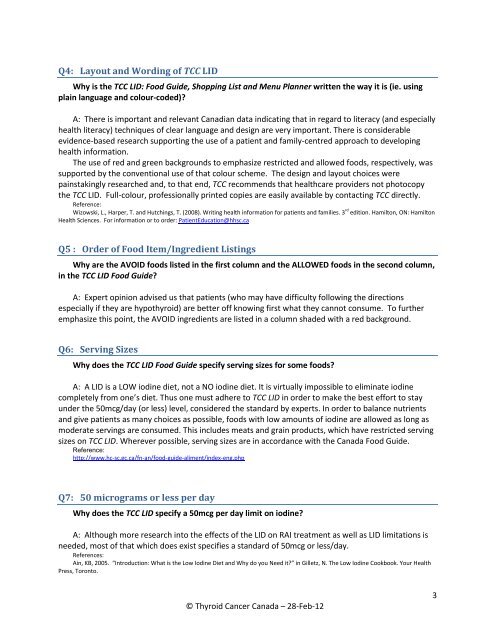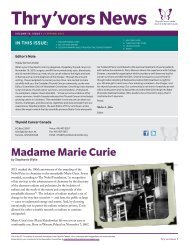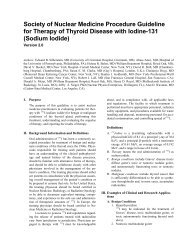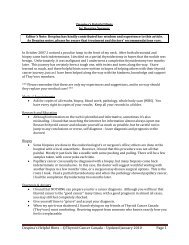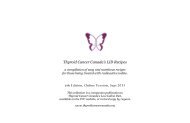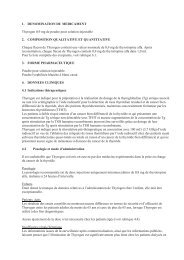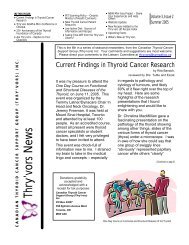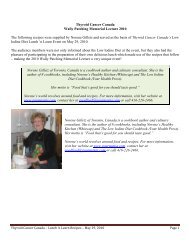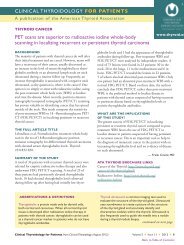Why a TCC LID? - Thyroid Cancer Canada
Why a TCC LID? - Thyroid Cancer Canada
Why a TCC LID? - Thyroid Cancer Canada
You also want an ePaper? Increase the reach of your titles
YUMPU automatically turns print PDFs into web optimized ePapers that Google loves.
Q4: Layout and Wording of <strong>TCC</strong> <strong>LID</strong><strong>Why</strong> is the <strong>TCC</strong> <strong>LID</strong>: Food Guide, Shopping List and Menu Planner written the way it is (ie. usingplain language and colour-coded)?A: There is important and relevant Canadian data indicating that in regard to literacy (and especiallyhealth literacy) techniques of clear language and design are very important. There is considerableevidence-based research supporting the use of a patient and family-centred approach to developinghealth information.The use of red and green backgrounds to emphasize restricted and allowed foods, respectively, wassupported by the conventional use of that colour scheme. The design and layout choices werepainstakingly researched and, to that end, <strong>TCC</strong> recommends that healthcare providers not photocopythe <strong>TCC</strong> <strong>LID</strong>. Full-colour, professionally printed copies are easily available by contacting <strong>TCC</strong> directly.Reference:Wizowski, L., Harper, T. and Hutchings, T. (2008). Writing health information for patients and families. 3 rd edition. Hamilton, ON: HamiltonHealth Sciences. For information or to order: PatientEducation@hhsc.caQ5 : Order of Food Item/Ingredient Listings<strong>Why</strong> are the AVOID foods listed in the first column and the ALLOWED foods in the second column,in the <strong>TCC</strong> <strong>LID</strong> Food Guide?A: Expert opinion advised us that patients (who may have difficulty following the directionsespecially if they are hypothyroid) are better off knowing first what they cannot consume. To furtheremphasize this point, the AVOID ingredients are listed in a column shaded with a red background.Q6: Serving Sizes<strong>Why</strong> does the <strong>TCC</strong> <strong>LID</strong> Food Guide specify serving sizes for some foods?A: A <strong>LID</strong> is a LOW iodine diet, not a NO iodine diet. It is virtually impossible to eliminate iodinecompletely from one’s diet. Thus one must adhere to <strong>TCC</strong> <strong>LID</strong> in order to make the best effort to stayunder the 50mcg/day (or less) level, considered the standard by experts. In order to balance nutrientsand give patients as many choices as possible, foods with low amounts of iodine are allowed as long asmoderate servings are consumed. This includes meats and grain products, which have restricted servingsizes on <strong>TCC</strong> <strong>LID</strong>. Wherever possible, serving sizes are in accordance with the <strong>Canada</strong> Food Guide.Reference:http://www.hc-sc.gc.ca/fn-an/food-guide-aliment/index-eng.phpQ7: 50 micrograms or less per day<strong>Why</strong> does the <strong>TCC</strong> <strong>LID</strong> specify a 50mcg per day limit on iodine?A: Although more research into the effects of the <strong>LID</strong> on RAI treatment as well as <strong>LID</strong> limitations isneeded, most of that which does exist specifies a standard of 50mcg or less/day.References:Ain, KB, 2005. “Introduction: What is the Low Iodine Diet and <strong>Why</strong> do you Need it?” in Gilletz, N. The Low Iodine Cookbook. Your HealthPress, Toronto.© <strong>Thyroid</strong> <strong>Cancer</strong> <strong>Canada</strong> – 28-Feb-123


